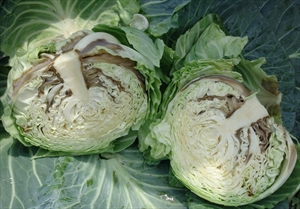- Worldwide distribution. A soil bacterium; common on cabbage, celery, carrot, Chinese cabbage, potato, and more.
- Infection via wounds at planting/harvest, and by insects.
- Large brown slimy areas on outer leaves, affecting the 'head' and stem, causing wilts and soft rots in field in wet, warm weather. Rots occur in transit and storage.
- Spread by rain splash, knives and insects.
- Cultural control: raised beds to improve drainage; straw/grass mulch; space plants; care when weeding; remove diseased plants; disinfect (bleach) knives used for trimming plants at harvest; avoid harvesting when wet; store at 4ºC; collect, burn/bury debris; 2-3-year crop rotation.
- Chemical control: none recommended.
Pacific Pests, Pathogens and Weeds - Online edition
Pacific Pests, Pathogens, Weeds & Pesticides
Lettuce soft rot (289)
Lettuce soft rot, bacterial soft rot
Pectobacterium carotovorum subsp. carotovorum (previously, Erwinia carotovora pv. carotovora, Erwinia carotovora subsp. carotovora, and also Erwinia aroideae). Other bacteria species may also be present in the soft rots.
AUTHOR Grahame Jackson
Information from Diseases of vegetable crops in Australia (2010). Editors, Denis Persley, et al. CSIRO Publishing. CABI (2019) Pectobacterium carotovorum subsp. carotovorum (bacterial root rot of sweet potato). (https://www.cabi.org/cpc/datasheet/21913). Photo 1 Sandra McDougal, NSW Department of Primary Industries, Yanco. Photo 2 Gerald Holmes, California Polytechnic State University at San Luis Obispo, Bugwood.org.
Produced with support from the Australian Centre for International Agricultural Research under project PC/2010/090: Strengthening integrated crop management research in the Pacific Islands in support of sustainable intensification of high-value crop production, implemented by the University of Queensland and the Secretariat of the Pacific Community.





